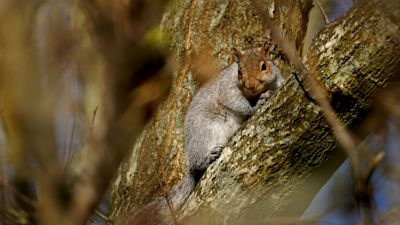Animals 'could face food shortages as trees under immense stress from climate change'

Woodland creatures could see their food supplies drop this winter as trees around the country are being put under immense stress and are struggling to survive due to climate change, the National Trust has warned.
The UK experienced record-breaking temperatures earlier this year, including a high of 40C in July, which contributed to drought and early fruiting of nuts and berries.
The National Trust, the UK’s leading conservation charity, has said this could affect squirrels and jays if nuts and berries fall from trees prematurely.
Pamela Smith, Senior National Gardens and Parks Consultant at the National Trust said: "Rowan berries for instance would typically stay on the trees until Christmas, but some are already falling now - which could affect food stocks for wildlife.
"This bountiful period and glut of food may impact our wildlife during the winter months with not so much food available when they need it most."
Want a quick and expert briefing on the biggest news stories? Listen to our latest podcasts to find out What You Need To Know
She recommends that people with gardens or green space to "garden with wildlife in mind", for example by digging a pond and planting fruit and nut hedges such as blackthorn or hazel.
Other ways to encourage nature closer to home, is by leaving areas of grass unmown and keeping the area around the compost heap unmanaged, which helps wildlife find shelter, food and water during the winter months.
The start of autumn is usually noticed by the changing colour of trees, but the charity is cautioning that trees will be heavily impacted by the warming climate unless urgent action is taken to tackle climate change.
Signs of this have been seen across the UK with many thinking autumn had arrived early with brown leaves falling to the ground in August.
However, this phenomenon, known as a 'false autumn', is due to the drought and trees simply not having enough water.
This could mean that tree leaves may take a more golden-brown and yellow colour instead.
Autumn colours only tend to show when the overnight temperatures starts to fall, although it has to remain above freezing.
Ms Smith thinks the north will be a good first indicator of how good this year's autumn colour will be as the phenomenon will spread to the south across the country from there.
John Deakin, Head of Trees & Woodlands, said: "We have witnessed first-hand how they have weathered this year's summer by drawing back moisture from leaves, which has resulted in some brown leaves desiccating and dropping to the ground already."
Mr Deakin said: "Despite their potential to span millennia, trees will struggle to survive consecutive summers of searingly hot temperatures and not enough rain.
"The damage to their vascular system and energy reserves is cumulative and may reach crisis point meaning we will unfortunately see more trees starting to decline and die, and they'll also be more susceptible to pests and disease."
He continued: "However, we know that some species will prove more resilient to the increase in extreme weather events and pests and diseases than others. Therefore, species diversification is a part of the answer to climate impacts."
The National Trust has big ambitions around tree planting, with a target of planting and establishing 20 million trees by 2030.